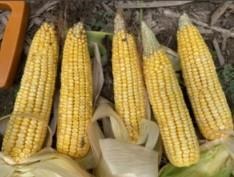By Osler Ortez and Alexander Lindsey
Despite a late start in many areas on the 2022 crop season, during the last days of September and early October, combines started to roll around the state. On October 3 (week ending 10/02/2022), USDA reported 7% of corn harvested from grain in Ohio (slightly behind the 10% harvested last year and the 5-year average for this time of the year). You can access their full report here. On the same report, >90% was dented, and >50% was mature. According to this report, corn condition was rated 64% good to excellent, which held close to reports earlier in the growing season.

Corn Ears
Despite 2022 being another challenging year, yield forecasts (see Table 1) show a high probability of near or above long-term average yields in Ohio (between 207 and 250 bu/Ac for the analyzed locations). Certainly, this would apply if adequate conditions persisted in the growing season. Fields planted too early, too late, or affected by other factors (e.g., replanting, soil crusting, dry periods, pest, disease) would not be expected to yield that well.
Whichever is the case, the field season is not complete until harvest is done.
Here is a list of considerations as corn harvest decisions are being made:
Physiological Maturity
The R6 growth stage happens approximately 55 to 65 days after silking (R1 stage). Physiological maturity comes right after the milk line in the kernel has disappeared. Also, it is important to note that physiological maturity technically happens before one can see the black layer in the kernel tips. However, checking for the presence of the black layer inside kernels is the common method used to verify that the R6 stage has been achieved. The R6 stage is the time when maximum kernel dry weight is reached. The moisture of kernels is close to 30-35 percent, but this can be variable, depending on factors like the genetics and the environment.
Field drydown
Various factors can drive slow or delayed grain drydown of mature corn grain before harvest, resulting in higher grain moisture at harvest. Harvesting higher moisture grain brings more drying costs (and time). Overriding observations on the in-field grain drydown of mature corn grain from Indiana included (Nielsen, 2013):
- Weather conditions (sunshine, rainfall, temperatures, wind) strongly influence drydown.
- Plant characteristics (husk coverage, husk thickness, number of husk leaves) can also influence drydown.
- Early grain maturation usually means faster drydown.
- Later grain maturation usually means slower drydown.
In general, the combination of warmth, sun, and higher wind speeds all encourage drydown compared to colder temperatures, cloudy skies, and low wind or high humidity/rain. Conditions favorable for drying tend to be present earlier in the fall rather than later.
Plant standability, grain quality, and harvest losses
Although the crop can be physiologically mature, non-favorable conditions can compromise the standability of stalks or lead to ear rots (decreasing grain quality or marketability). Several years back, an Ohio study evaluated the effects of plant populations (24K, 30K, 36K, and 42K plants/Ac) and three harvest dates (early-mid October, November, and December) on the agronomic performance of four hybrids (with different maturity and stalk quality). The results of this study provided insights into yield losses, changes in grain moisture, and stalk quality associated with delaying harvest.
Key findings of this work:
- Nearly 90% of the yield loss associated with delayed corn harvest occurred when delays extended beyond mid-November.
- Grain moisture decreased by nearly 6% between October and November harvest dates. Delaying harvest after early to mid-November achieved almost no additional grain drying.
- Higher plant populations increased grain yields when harvest occurred in early to mid-October. When the harvest was delayed until mid-November or later, yields declined at plant populations above 30K/acre.
- When the harvest was delayed, hybrids with lower stalk strength ratings exhibited greater stalk rot, lodging, and yield loss. An early crop harvest of these hybrids eliminated this effect.
- The highest increase in stalk rot incidence occurred between October and November harvest dates. Stalk lodging increased mainly after early mid-November.
- Harvest delays had little or no effect on grain quality characteristics such as oil, protein, starch, and kernel breakage.
Corn Drydown Calculator
Iowa State University has made available an online corn drydown calculator that can help users to estimate grain drydown in fields located in the Corn Belt region. Access the tool here: https://crops.extension.iastate.edu/facts/corn-drydown-calculator
A Field Loss Calculator for Field Drying Corn
Additionally, the University of Wisconsin developed a Harvest Field Loss Calculator Excel spreadsheet. That can be accessed here: http://corn.agronomy.wisc.edu/Season/DSS.aspx. The Excel file allows calculating the costs of harvesting versus letting the crop stay in the field and harvest later. The spreadsheet includes scenarios for higher drying costs versus grain losses during field drying. It also accounts for elevator discounts and grain shrink.
Source : osu.edu